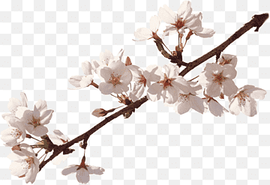Get the most important tech news in your inbox each week.
Cursed Images: A Short History of The Uncanny

Consensus has come to define a cursed image as any image that can incite the five Ws in a viewer’s curiosity: who, what, when, where and why. When the clarity of information like these key details are lacking from an image, it is inevitable, there are more questions than answers. We take a look at the history of these images, from the early day of surrealism to the present day.
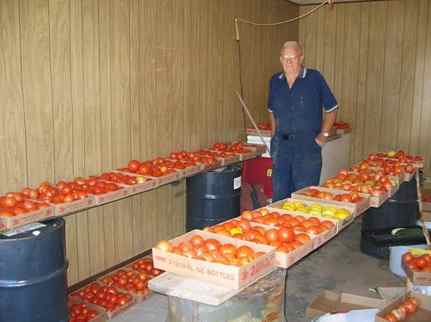
The first image ever posted to the blog depicted a man surrounded by crates of red tomatoes in a wood-effect melamine panelled basement, the kind of banal everyday Americana interior afficionados of William Eggleston and Stephen Shore are familiar with. “It’s the perfect cursed image to me because there’s nothing inherently unsettling about any part of it,” said the blogger “It’s a totally mundane moment transformed into something else by the camera and the new context I’ve given it.”
The five Ws are most commonly derived from a found analogue (non-photoshopped) image that has been taken with an old flash camera or phone. The image often has an improvised or amateurish feel, containing odd effects of light, often from a flash, random and puzzling items placed in incongruous places or in unusual ways. Somehow things are not how our brains believe they are supposed to be, and this prevailing sense is our predominant source of unease or disquiet. They lurk in every dark recess of the online world, passed around in group chats, social media and amidst the digital margins. Their sources and participants are unknown and unknowable—circulated oddments of a culture or system of behaviour passed from one individual to another—car crash viewing with the visceral cocktail of unease, horror, repulsion and bewilderment.
Whilst this kind of imagery may be a relatively new online phenomenon, drip fed into our lives through the omnipotence of the internet and the joined-at-the-hip reliance we all have on connected devices, the kind of disquiet propagated by cursed images has long been a source of fascination for artists.
A Short History of the Uncanny
First identified by Ernst Jentsch in his 1906 essay On the Psychology of the Uncanny, Sigmund Freud popularised the term a decade later with his 1919 essay The Uncanny. The concept of “the uncanny” can be considered an apt explanation of why we find “cursed images” so…cursed. Described as the psychological experience of something as strangely familiar, or as Jentsch illustrated as an experience of “intellectual uncertainty”, the concept of the uncanny is difficult to describe as it is rooted in deeply personal reactions to visual stimuli. However, Freud’s essay outlines prevailing themes that could elicit the feeling of the uncanny, of which “applies to everything that was intended to remain secret, hidden away, and has come into the open”. Experimenting with, and replicating this revulsion, fear, and discomfort that comes with exposure to the uncanny or cursed images has fascinated visual artists since its coining.
Surrealist artists can be considered some of the first artists to expressly explore the concept of the uncanny in their work. With an aim to reject a rational and literal portrayal of life, the artists focus on dreamlike worlds full of magic, distortion, horror, and the unconventional. Their philosophy, labelled “surrealist” or “beyond reality”, was explicitly expressed by André Breton in his 1924 Surrealist Manifesto which explained the movement as: “pure psychic automatism, by which one proposes to express, either verbally, in writing, or by any other manner, the real functioning of thought. Dictation of thought in the absence of all control exercised by reason, outside of all aesthetic and moral preoccupation.”
Beyond surrealism, the abject art movement of the late 20th century could be considered a great contributor to the creation of “cursed images” and “the uncanny” in artistic practice. Developed by Julie Kristeva in her 1980 book Powers of Horror, abjection can be considered a complex psychological, philosophical, and linguistic concept influenced by bodily functions and aspects of the body that are deemed unclean or inappropriate for public display. Kristeva explained, “refuse and corpses show me what I permanently thrust aside in order to live”. The exploration of this underbelly of humanness was pioneered by feminist artists in response to the patriarchal view of the female body. Though surrealists and abject artists may create with different goals, philosophies, and mediums; they are united in the creation of portrayals of the uncanny in contemporary art; bringing what is seen in popular culture as cursed images into galleries, museums, and the unconscious for decades.
Cursed Images: Photo Examples
Have a look at these unsettling examples of modern and contemporary artworks that demonstrate how the ‘cursed image’ has been with us for much longer than perhaps many of us realised.
Hans Bellmer

German artist Hans Bellmer (1902-1975) is considered one of the first practitioners of Surrealist photography, and is best known for his work portraying life-sized female dolls. Produced throughout the mid-1930s Bellmer explored the uncanny through his creation of these large dolls, and the display of the almost-but-not-quite humanness of their form. Missing limbs, the shortening of the existing ones, and creating mask-like faces for these pubescent “girls” led the viewer to a nervousness and fear when observing Bellmer’s works. Dripping with an unsettling eroticism, his work served as the inspiration for future humanoid figures, such as the 2001 anime film the Ghost in the Shell 2: Innocence.
William Eggleston

American photographer William Eggleston (1939-) explored the everyday surrealism of the mundane landscape of middle America. His focus on the banal has long been the visual inspiration for photographers and film directors such as David Lynch, Gus Van Sant, and Sofia Coppola’s deeply unsettling and bold visual languages. One of his most famous works, The Red Ceiling or Greenwood, Mississippi, 1973 has been said to, despite the mundane subject of a simple lightbulb in a ceiling, portray “some indefinable sense of menace”. Eggleston himself has explained the work, “When you look at the dye transfer print, it’s like red blood that’s wet on the wall. It shocks you every time”. The overpowering decor, coupled with the sexual positions poster on the wall (an item still available for $11 in Walmart today) adds a leering menace to a weirdly off kilter environment.
Diane Arbus

Often described as “the icon of the uncanny” in contemporary photography, American photographer Diane Arbus’ (1923-1971) photograph, Identical Twins, Roselle, New Jersey, 1967 was the direct inspiration for Stanley Kubrick’s use of twins in The Shining. However, this image’s relation to the uncanny was by no means a novel thematic exploration for Arbus, who spent her career seeking out the abnormal, strange, and unseen characters of America. Focusing her camera on the members of carnivals, nudist colonies, and mental institutions; Arbus populated her oeuvre with what might be considered the “cursed images” of those unfortunates on the fringes of society. Depicted with matter of factness and no small measure of compassion and acceptance, the subjects’ ‘otherness’ is a quality that creates unease even today.
Stephen Shore
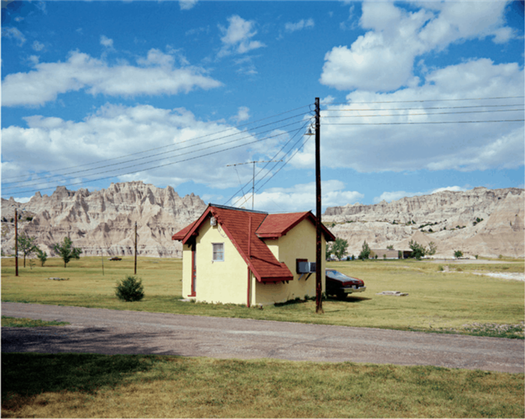
Like Eggleston, American photographer Stephen Shore (1947-) is best known for his images of everyday life, ordinary things across great swathes of the North American continent that we look at but never see. A pioneering force in recording the banal landscapes of Middle America as something noteworthy, his images are populated with gas stations, grocery stores, and fast food establishments. The lack of people and human life in his works, the confusion of scale and blurriness of perception, and the eerie and depressive emptiness of his photographs all work together to evoke this feeling of a cursed image in his audiences; somehow unsettling since the artist has managed to reveal things that, despite their all almost complete non- descriptness, are still somehow richly evocative.
Joel Sternfeld
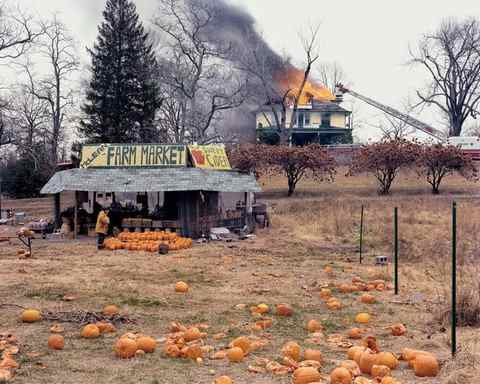
Often exploring humanity at odds with nature, time, or circumstance; photographer Joel Sternfeld (1944-) is known for chronicling a side of America not often seen in mainstream documentary photography. Sternfeld’s images capture an almost-normal portrayal of American landscapes, seen in images such as McLean, Virginia, December 1978, in which a suited firefighter calmly chooses a pumpkin from a pastoral stand while a massive fire blazes in the background. Though very close to a “normal” scene, the disparity between the serene action of the firefighter and the immediate need of his services in the background puts the viewer in a state of unease, experiencing the effects of the uncanny, or cursed image. What is largely unknown by the viewer is that the fire was a drill for the fireman and his crew, making his perusal of the pumpkins less alarming than would seem to be the case.
Paul McCarthy
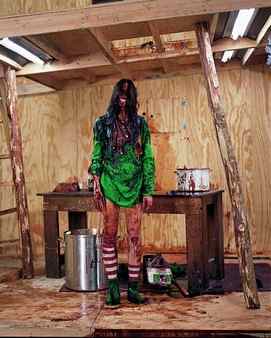
With an oeuvre so disturbing and fear-inducing contemporary artist Paul McCarthy’s (1944-) work alone could have populated this, and hundreds of subsequent articles on cursed images and the uncanny. As a major figure in art known as ‘Abject’ McCarthy has worked in painting, performance, film, and installation art; all in line with typically American themes of consumerism, fetishism, and the mass media while playing with the style and format of the European avant-garde. His works have consistently pushed the boundaries of what his audience would tolerate, turning beloved childhood figures like Disney characters, or Santa Claus and his elves, into the subject for pyschosexual nightmarish films and performance. A master of the grotesque, McCarthy paints a portrait of each and every sickness, psychosis, and the states in between.
Cindy Sherman
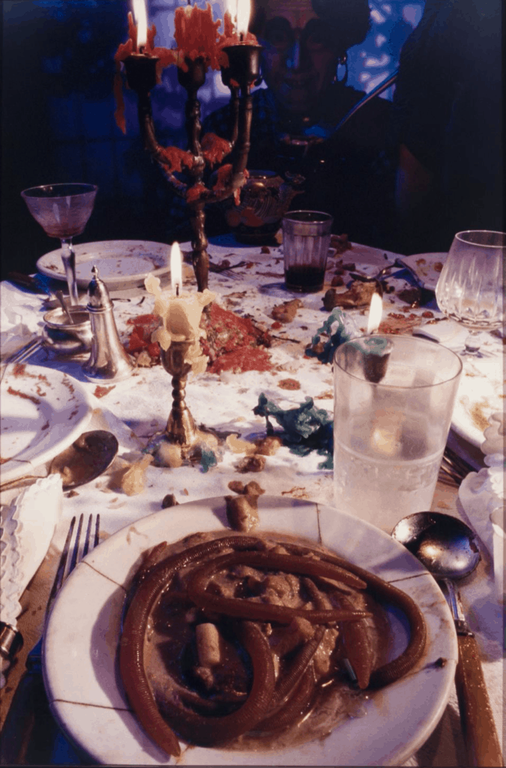
Best known for her film and media-inspired photography Cindy Sherman (1954-) has been producing unsettling and popular images that evoke the feeling of film stills, moments of drama caught in time for over 40 years. Sherman also experimented more explicitly with the uncanny and cursed images in her “disgust series” from 1986-1987. This series of untitled images portray subject matter related to female bodily functions, in the tradition of feminist abject art. Utilising forms that are familiar, yet uncannily incongruous, inappropriate or just removed from their rightful context, Sherman manages to unnerve, disgust and entertain in equal measure.
Gregory Crewdson

Known for his surrealist staged photographs of suburbia that utilise props and lighting to create dream-like narratives, Gregory Crewdson’s (1962-) work capitalises on his viewer’s shifting perceptions of reality. Directly influenced by the work of fellow uncanny artist Diane Arbus, Crewdson’s photography is increasingly involved in lavish movie scale productions; necessitating staging, lighting, and a crew of subjects. His work is inherently “unreal”, showcasing a side of humanity that is life-like enough to remind the viewer of themselves, while still radiating the unnerving lack-of-reality in which they are created. Evocative of the work of Stephen Shore and William Eggleston in their mundane Middle America subject matter, whilst also recalling some of the unnerving elements of the works of Stephen Spielberg and Stephen King, Crewdson’s otherworldly staging and props take his photographs to their cursed image extreme.
Alec Soth
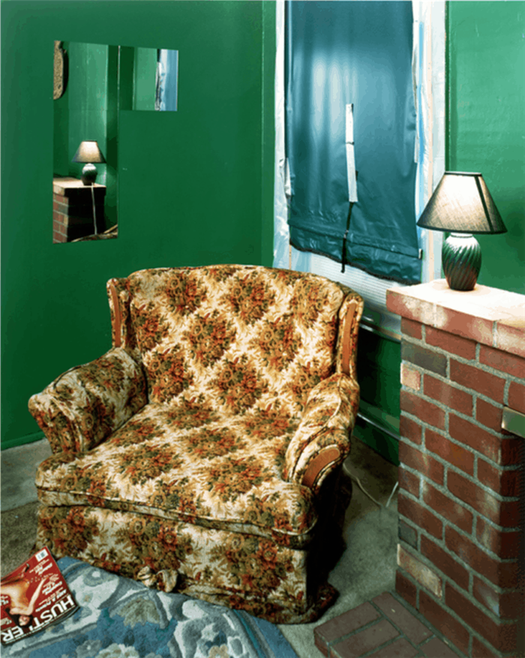
Using previously unexamined places for the subject of his photography Alec Soth’s (1969-) images present an uncanny world where traces of human activity lie everywhere, even when the people themselves are unseen. His images of abandoned furniture, a broken bed with plants growing through the frame or a rolling desk chair left at the edge of a lake, leave viewers with a creeping sense of dread upon viewing this world in which only vestiges of their presence is depicted. His colourful print Sugar’s, Davenport, IA, 2002 presents an empty orange-patterned chair and redbrick fireplace in contrast with violently green curtains and painted walls. The woman on the cover of the Hustler magazine at the foot of the chair stares up at the ceiling while laying upon a rumpled rug, disturbed and disturbing at once.
Roe Ethridge
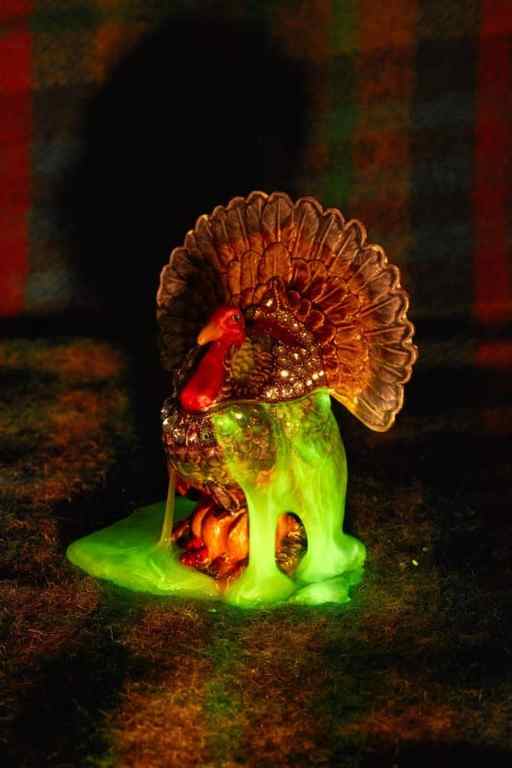
Best known for his fashion and commercial photography Roe Ethridge (1969-) has made a name for himself as a heavily stylised photographer characterised by a wry wit and technical sophistication. Interested in combining the glossy commercialised style of magazine photography with highly personal subject matter, Ethridge’s work comes off as familiar but removed, uncanny in its relationship to reality. Utilising generic materials, like a plastic salt and pepper shaker turkey, to explore themes of commodification and image; he plays with traditional Dutch portraiture and still-life styles whilst using contemporary objects. By utilising real objects paired with vaguely unbelievable circumstances, Ethridge’s images often come down on the creepy side of banality in their parallels to cursed images.
Here’s what makes the perfect ‘cursed image’
This week was Upvote Everything Day on Imgur (the procrastination black hole I spend way too much time on). So instead of the usual feel good fluff and pandering cute pet pics, the front page was crowded with GIFs of women giving birth to candy abominations and video clips of lederhosen-clad German pop-folk music weirdos. Just like god intended.
However, it also usually brings to the fore one of my all time favorite types of content (or at least the one I mildly obsess over), cursed images.

I have a horrid fascination with cursed images. What interests me is why exactly an amalgamation of seemingly mundane objects unsettles me so much. I also start to wonder about the story behind each image, imagining what was going through the artiste’s mind and the awkward amount of work and forethought that had gone into it to make it reality — and all without a guarantee of ‘success’ or any sort of recognition.
Of course, there’s a wide range of photos that constitute ‘cursed images’ — snapshots of weird moments, uncanny photoshop jobs, and pics of things that are always unsettling, no matter the context — but to me the true cursed images are the ones that require determination and physical execution.
The latest rumblings from the EU tech scene, a story from our wise ol’ founder Boris, and some questionable AI art. It’s free, every week, in your inbox. Sign up now!
Just like handmade artisanal items, we enjoy them for their quality and apparent skill of the creator . The best cursed images are the ones that show people rearranging their daily reality in a new and challenging way — just for the sheer joy of creation.
Take, for example, the heroes that undertake the humiliating task of cleaning out a laptop’s CD-drive after pouring it full of baked beans. Or the visionary who spent hours waiting for their clam chowder popsicles to be sufficiently frozen for a photo opportunity. There must be a point in the creative process where crippling self-doubt settles in and they are forced to ask themselves ‘why am I doing this, what am I doing with my life?’
But the brave people behind these images have persevered and overcome the doubt instilled in us by traditional societal convention. I salute these people for their selflessness and contribution to a free and open society.

But what then are the actual building blocks of a properly ‘cursed’ image? How can we push our fellow people into truly seeing their environment, by jarring them into a new state of awareness with challenging imagery?
After careful analysis, the building blocks of the proper cursed aesthetic are:
- Defamiliarization — the artistic technique of presenting to audiences common things in an unfamiliar or strange way in order to enhance perception of the familiar. E.g. putting dish soap on waffles or locking toes together with multiple people at once.
- High contrast, flash photography — the lighting in the most powerful photos often has a film-like feel to it, a reminiscence of where we’ve come from but also painting our past as sordid and dirty. Flash photography might also invoke a feeling of being exposed for what we really are. A bright flash of light, unveiling all the faults we’ve tucked away in the darkness — like our toes, which are universally disgusting.
- Recasting food as a reminder of mortality and lack of agency — food is a common theme in DIY cursed images. The presence of unappealing food quietly reminds us of the carnal element of our existence. Food crosses the boundaries of our bodies and we’re sickeningly dependent on it, reminding us we’re never fully in control of our surroundings or an independent force in this world. It also shines a light on how ashamed we are of our bodily functions (probably some Freudian shit) as they poke a hole in the lie we constantly tell ourselves that we’re completely cerebral beings, above the filthiness surrounding the lives of animals. That’s why introducing foods such as milk in new, unexpected circumstances forces us to face the fact that no matter how much we advance, we’re still fettered by our base needs.
In these trying times, we need everyone to think of how they can give back to society and add to the general benefit of humanity.
So long story short, I put a ketchup smiley on my little brother’s foot and made him dip his toes into soggy cereal and took a pic. You’re welcome.

Plus a bonus behind-the-scenes pic taken by my mom. If you hated this article, don’t @ me.

The original version of this article was first published in our weird little daily newsletter, Big Spam. Sign up here, you might regret it.
Story by Már Másson Maack
Editor, Growth Quarters by TNW
Már tries to juggle his editorial duties with writing the occasional weird article. He also loves talking about himself in the third person. Már tries to juggle his editorial duties with writing the occasional weird article. He also loves talking about himself in the third person.
The Internet’s Cursed Images Are Creeping People Out on Twitter
The mysterious @cursedimages has 98k followers and over 300 creepy found photographs.
Jill Blackmore Evans October 28, 2016

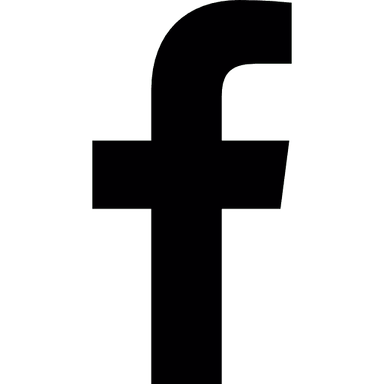

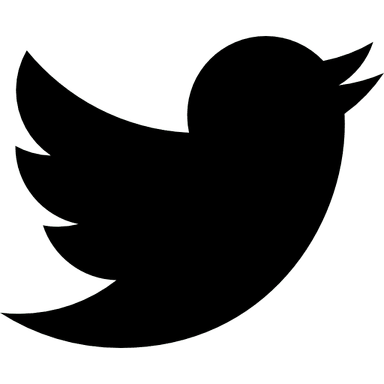
Share this article
It’s hard to pinpoint what’s so fascinating about the found photos on @cursedimages, a Twitter feed that has been sharing unsettling, context-less images, labelled only with seemingly random numbers, since late July. The account bio reads simply “all of these images are cursed.”
Cursed Images has over 98k followers and a mysterious account administrator insists on total anonymity. When approached by The New Yorker for an interview, the creepy curator declined a phone call and allowed only emailed questions, explaining, “Some people have stated I’m a bot. Others think I’m a creep with too much time on their hands. But it’s just like the lack of context for the images. Whoever you think I am, that’s what I am.”
The found photography on Cursed Images ranges from near-apocalyptic fires and floods, to gross culinary creations, to uncomfortable social events and poorly thought-out Halloween costumes. Even the relatively pleasant images in the feed are made creepy by their inclusion. Why is this shot cursed, you’re forced to ask, considering the possibility that something awful is about to happen outside of the frame, or that there’s a hidden, horrible meaning to the image that you’ll never understand.
There’s just something deeply, uncomfortably creepy about stumbling across the low-res digital detritus of the early 2000s internet, unexpected, in your Twitter feed. Some of the images are so poorly focused and blurry that they look unreal, with strange smudges blurring the screen like photographic ghosts.
Find some of our favorite weird shots from Cursed Images below, and check out the rest on the original Twitter feed.




